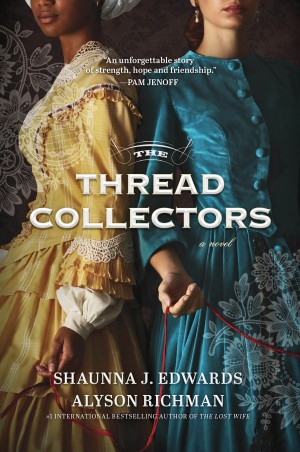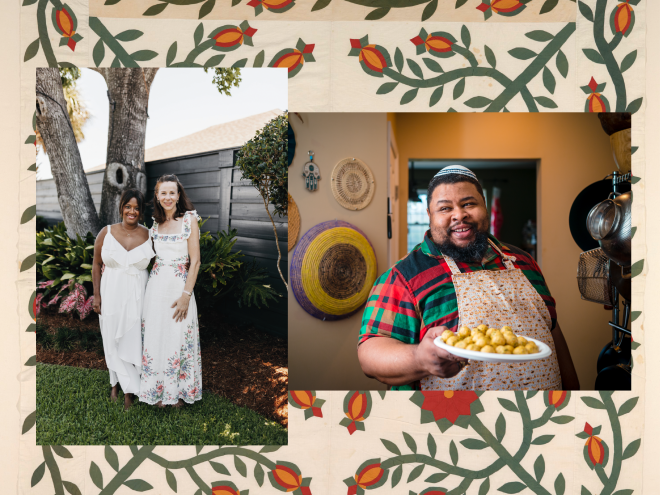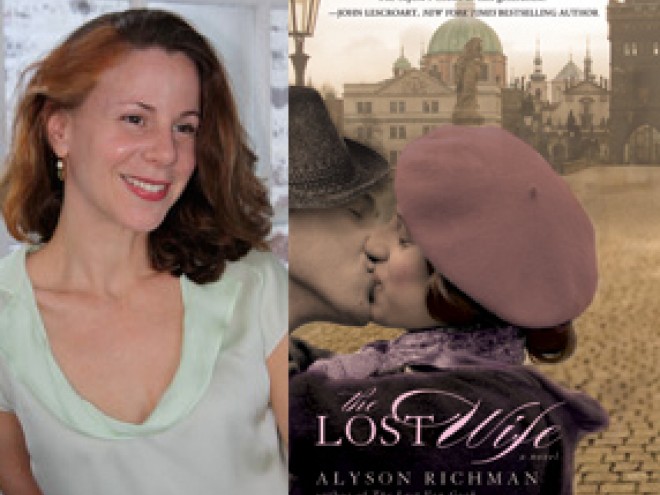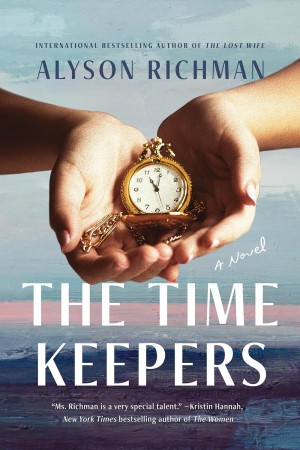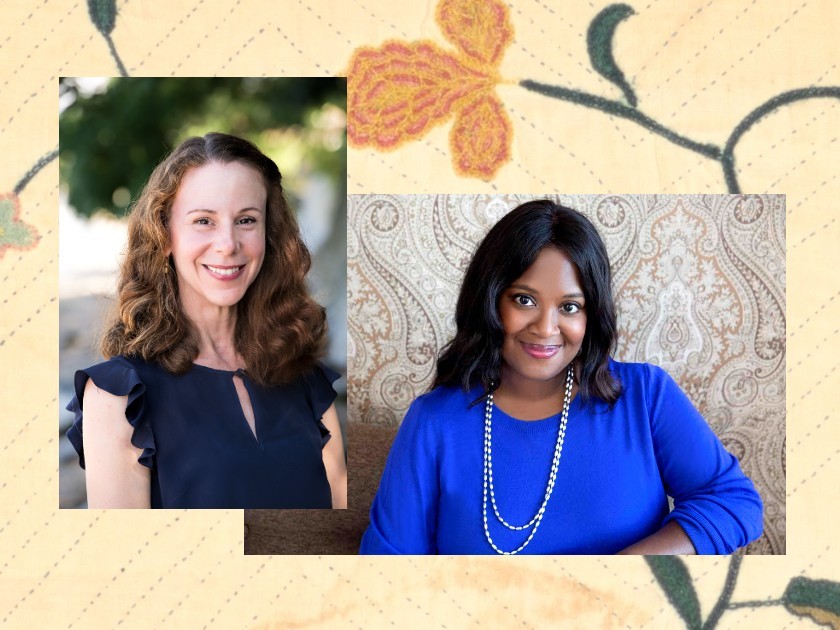
Author photo of Alyson Richman by Jeanine Boubli, Author photo of Shaunna J. Edwards by Ron Contarsy
Quilt background from The Metropolitan Museum of Art
Shaunna Edwards and Alyson Richman discuss the inspiration and history behind their captivating new book, The Thread Collectors.
Shaunna Edwards: Alyson, I remember when you had the first seeds of inspiration for our book, The Thread Collectors. Can you share that with us?
Alyson Richman: For years, I wanted to explore my own family’s connection to this period in history. At the time of the Civil War, only .05% of the total US population was Jewish and it is estimated that about 8,000 Jewish soldiers enlisted to fight. Despite such a small number of Jewish soldiers, within my own family tree I am related to two of these soldiers. One of my great-great-great uncles fought on the Union side and enlisted in the 31st Regiment of New York as a musician. In stark contrast, his older brother — who had moved to Mississippi years earlier — joined the Confederate army. As a child, I heard countless stories from her grandmother about how the brothers’ philosophical and moral divide irrevocably split the family. So that part of the story has been on the backburner of my mind for a while. In 2012, I was watching Ric Burns’ riveting documentary, Burying the Civil War Dead, which was inspired by much of the research in Drew Gilpin Faust’s book The Republic of Suffering: Death and the American Civil War. One segment of the documentary highlighted that, during the Civil War, soldiers sometimes created maps to mark where they’d buried their fellow soldiers. It also highlighted the Black soldiers who had enlisted to fight against slavery, but were often made to dig ditches to bury the fallen White soldiers. I instantly had a vision of a Black soldier who creates a map during one of our nation’s darkest times and the connections that map brings to him later on. A few weeks later we were meeting for a drink and I remember asking you for your input and you instantly said: “I see the map sketched at first, but maybe he gives it to his beloved who stiches it in embroidery to preserve it.” In one sentence, you opened up a whole new doorway to the story! I know it would take us nearly ten years later and a global pandemic for us to finally sit down and write this book, but it was those early thoughts and conversations that sparked what became The Thread Collectors.
Shaunna, what’s the most surprising thing that you learned from writing this book?
SE: In spite of how much Civil War history I have read, I never knew about the tragedy of Port Hudson, even though it happened in my home state of Louisiana. Impressively, there were 180,000 Black men who enlisted to fight in the Civil War — almost 10% of the Union Army — at a time when just enlisting required great hardship and risk. Most of those soldiers’ stories have been overlooked or lost.
Like many, I had always believed that the 54th Massachusetts Volunteer Regiment was the first military unit of Black troops to fight valiantly in the Civil War, as it was famously played out in the movie Glory. In fact, the Louisiana Native Guards fought at Port Hudson — and were massacred — weeks earlier. Hundreds of Black soldiers were sacrificed and their bodies lay unburied for days. The Guards included Black line officers (such as Captain André Cailloux who appears in our novel), even after General Nathaniel P. Banks began a systematic campaign to purge the Black line officers from the regiments. Reflecting the diversity and complexity of being “colored” in Louisiana at the time, the regiment included free men of color fighting alongside fugitive slaves that turned to the Union Army for a chance at dignity and freedom.
My husband and I visited Port Hudson on New Year’s Eve, and we definitely got a few confused looks as a Black couple tromping around a Civil War battlefield. Additionally, my husband is Jamaican, so my fascination with the Civil War seems quite strange to him. However, that is our shared history as Americans and we should all understand and embrace it, the darkness and the light.
Alyson, what was the most important thing about the research that you discovered?
AR: I really loved the discovery of the real life Jewish abolitionist and suffragist Ernestine Rose. She was an amazing woman — a true feminist who acquired the nickname: “Queen of the Platform.” Born in 1810 in Poland, she refused to marry the man her father had chosen for her. She then traveled to Berlin, Paris, England, and finally New York, where she cemented her role in female activism. By 1850, she was an essential figure in the women’s rights, anti-slavery, and free thought movements, in which she was the only Jew. Another fun fact is that she was the inventor of those scented lining papers you put in your drawers! When I discovered that, I knew I had to find a way to put that in our book too!
New Orleans is often described as the northernmost city of the Caribbean, a place of both religiosity and licentiousness where people of different races mixed and melded in ways that were unthinkable in other parts of America.
SE: Alyson, your books always have creative artists in them. This book has music. Can you discuss why this is important to you?
AR: I’m the daughter of an artist, so exploring the creative process against the backdrop of war has been a fixture in all of my novels. I love how you can see rays of light and enterprise even in times of great despair. With my novel The Lost Wife, I wanted to explore the Holocaust from an artist’s perspective and how the creative spirit could not be extinguished even in one of the darkest periods in history. In several of my other historical books, I’ve delved into the various challenges artists, musicians, actors, and even dancers faced during different periods of political turmoil. It’s something that’s really close to my heart! In The Thread Collectors, I know we both wanted to focus on how music helps forge a connection between our two male protagonists, Jacob and William. Regardless of their different backgrounds and religions, their shared love of music creates an unbreakable bond between these two men, sustaining them in so many different ways, most importantly in friendship and loyalty.
AR: Shaunna, this book takes place in the South. While you’re from the South, you were adamant about centering the story in New Orleans, where you were raised. Why is that?
SE: New Orleans is often described as the northernmost city of the Caribbean, a place of both religiosity and licentiousness where people of different races mixed and melded in ways that were unthinkable in other parts of America. In antebellum South, Congo Square in New Orleans was one of the few places where enslaved people were allowed to play their historically African music, dance, and celebrate. Free Blacks, enslaved people, and even adventurous White people would gather there. In The Thread Collectors, Stella and William’s burgeoning courtship also takes place there in a nod to Congo Square being a place where people would slip their bonds, even if just for an afternoon.
New Orleans is also a place where a substantial number of free Black people lived. While they didn’t enjoy the same rights as their White neighbors, they built thriving communities. Those New Orleanians and their rich history inspired the backstory of our character, Teddy, and his emotional arc. Just as Black Americans today have a wide array of experiences, it is important that we illuminate the diversity of the Black experience in history.
What’s your go-to writing ritual?
SE: While I was constantly dreaming of our passion project, I also have a full time job, so my writing often happened in the early mornings or over the weekends. As a former lawyer, however, I am not daunted by a large project or a blank page. On Saturdays, I would awaken before my husband (and we are newlyweds, so this is a sacrifice), slip on my “writing caftan,” and start with a strong cup of coffee while my rose gold MacBook Air booted up. Putting on one of my brightly-colored caftans always makes me feel more inspired, creative, and unfettered.
AR: I need a literal “room of one’s own” to create my characters. I’m fortunate enough to have a small office, which I stock with necessities like rose tea. My children are older now — one is even in college — but they knew from an early age that my writing room was off limits. Now I welcome them in to share my newest stories. During the pandemic, I was working on two other books and for the first time in my writing career, I also wrote on the weekends! With no place to go, to travel, it was a great escape to be able to fall into my book projects and create a new world with characters that were making incredible journeys and triumphing over adversity.
SE: Alyson, early on you told me that your characters tell you where they want to go. What do you see next for these characters when we leave them in the last chapter?
AR: Yes, I always love endings that are not wrapped up in a tidy bow. I think it’s important to bring your readers to a point where you’ve answered the essential questions that propelled you to write the story, but that you leave the reader with a sense that a new chapter is beginning for your characters. We obviously don’t want to reveal the ending of our novel in this interview, but let’s just say I know we’d both like to continue the journey and follow these characters, their children, and their grandchildren, through different periods in history. For example, in Reconstruction, the Jazz Age, and the Civil Rights era. It feels like a true legacy project to do something with that sense of purpose!
Shauna J. Edwards has a BA in literature from Harvard College and a JD from NYU School of Law. A former corporate lawyer, she now works in diversity, equity and inclusion. She is a native Louisianian, raised in New Orleans, and currently lives in Harlem with her husband. The Thread Collectors is her first novel. Find her on Instagram, @shaunnajedwards.
